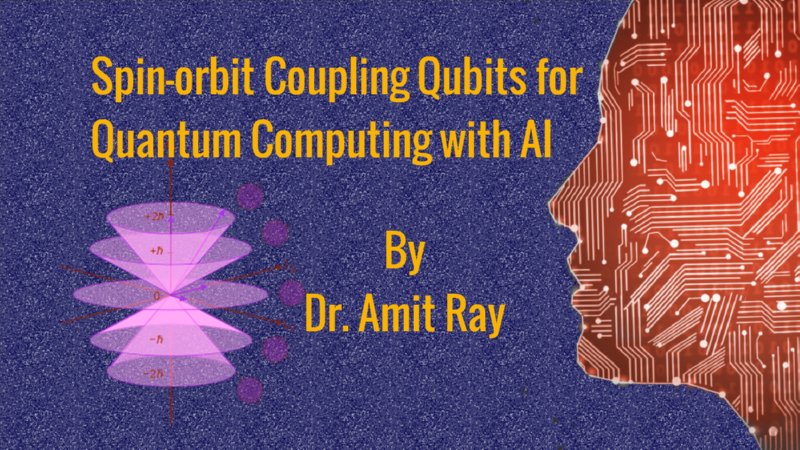The Power of Spin-orbit Coupling Qubits for Quantum Computing
Here, Dr. Amit Ray discusses the power, scope, and challenges of Spin-orbit Coupling Qubits for Quantum Computing with Artificial Intelligence in details. Quantum computing for artificial intelligence is one of the key research projects of Compassionate AI Lab. We summarize here some of the recent developments on qubits and spin–orbit coupling for quantum computing.
In digital computing, information is processed as ones and zeros, binary digits (or bits). The analogue to these in quantum computing are known as qubits. The qubits are implemented in nanoscale dimensions, such as spintronic, single-electron devices and ultra-cold gas of Bose-Einstein condensate state devices. Manipulation and measurement of the dynamics of the quantum states before decoherence are the primary characteristic of quantum computing.

Involving electron spin in designing electronic devices with new functionalities and achieving quantum computing with electron spins is among the most ambitious goals of compassionate artificial superintelligence – AI 5.0. Utilizing quantum effects like quantum superposition, entanglement, and quantum tunneling for computation is becoming an emerging research field of quantum computing based artificial intelligence.
 Two of the most successful realizations of solid-state qubits are: spin-qubits and superconducting qubits. Quantum bits are generally considered to be constructed from the smallest form of matter, an isolated atom, ion traps and optical lattices, but they may likewise be made far larger than single-electron devices.
Two of the most successful realizations of solid-state qubits are: spin-qubits and superconducting qubits. Quantum bits are generally considered to be constructed from the smallest form of matter, an isolated atom, ion traps and optical lattices, but they may likewise be made far larger than single-electron devices.
Spin–orbit Coupling and Quantum Computing
The spins of an electron can be controlled by using electric fields, magnetic fields and the combination of electric and magnetic fields. In magnetic resonance imaging (MRI) machines the spins of the electrons are controlled by magnetic fields. Although electric fields do not directly influence spins of an electron, however they can indirectly influence the orbit of an electron around its parent atom’s nucleus.Compared with magnetic control of spins, electric control provides better results and more efficient. It allows access to electron spins at nanoscale. Charge-based quantum dot qubits offer superfast electric field manipulation and simple architectures. However, they suffer from rapid dephasing because charge noise also couples strongly with the qubits.
In quantum physics, the spin–orbit interaction is a relativistic interaction of a particle’s spin with its motion inside a potential. The spin–orbit interaction is also called spin–orbit effect or spin–orbit coupling. The spin angular momentum of electron can interact with its orbital angular momentum. This lead to splitting of different energy levels which can lead to different transition energies. This effect is known as spin orbit coupling.
An electron lives in a environment of electric fields, which forces the charged particle to move with some velocity. Due to the laws of electromagnetism, this motion gives rise to a magnetic field, which can affect the behavior of the electron and is an example of spin-orbit coupling. InAs nanowire, is a material commonly used for with a strong spin-orbit interaction, over an array of fine gate electrodes. Spin-orbit coupling using laser light in trapped ultra-cold gases of atoms could be used to manipulate the quantum states – like the “spin-up” and “spin-down” states in an electron. Radio frequency measurement techniques are used to overcome the the nanowire charges.
Quantum Computing and Quantum Entanglement
When particles are entangled, they share properties in a way that makes them dependent on each other, even when they are separated by large distances. Einstein famously called entanglement “spooky action at a distance,” as altering one particle in an entangled pair affects its twin instantaneously—no matter how far away it is. Tunneling through impenetrable barriers is one of the key properties of quantum particles.
It is difficult to detect the single particles accurately and they are often lost or obscured by background noise. So the task of producing them in entangled states, manipulating them, measuring the charges, spin, frequencies is often daunting. To overcome this challenge, begin with an ultra-cold gas forming a new state of matter known as a Bose-Einstein condensate. The atoms in the cold cloud now behave collectively and they are entangled. Hence, Quantum computing requires extremely cold temperatures, as sub-atomic particles must be as close as possible to a stationary state to be measured. The cores of quantum computers operate at -460 degrees f, or -273 degrees c, which is 0.02 degrees away from absolute zero.
Key Issues of Quantum Computing
Quantum transitions do not adhere to the Landau Zener law as it was initially thought. This is mainly due to the transition of a huge number of spin levels at the same time. Qubit decay due to tunneling processes is one of the key issue. Another major stumbling block in creating quantum computers is decoherence of the participating quantum systems (qubits). Decoherence turns the quantum state into a classical mixture. Decoherence collapses the wavefunction in quantum mechanics. Qubit cross talk and information exchange measurements requires further explorations.
Conclusion:
Quantum computers will play an ever more important part in the behavior of many emerging field of modern artificial intelligence. A large-scale quantum computer fully programmable like classical computers is a major objective of modern research. To scale up a quantum computer to higher levels is a major challenge. The loss of quantum coherences depends crucially on the interaction with the local environment. Spin-orbit coupling using laser light in trapped ultra-cold gases of atoms could help realize the true power of quantum computing and the power of artificial intelligence.
References:
- Ray, Amit. “Spin-orbit Coupling Qubits for Quantum Computing and AI.” Compassionate AI, vol. 3, no. 8, 20 August 2018, pp. 60-62, Compassionate AI Lab, https://amitray.com/spin-orbit-coupling-qubits-for-quantum-computing-with-ai/.
- Ray, Amit. “Roadmap for 1000 Qubits Fault-tolerant Quantum Computers.” Compassionate AI, vol. 1, no. 3, 15 March 2019, pp. 45-47, Compassionate AI Lab, https://amitray.com/roadmap-for-1000-qubits-fault-tolerant-quantum-computers/.
- Ray, Amit. “Quantum Computing Algorithms for Artificial Intelligence.” Compassionate AI, vol. 3, no. 8, 22 August 2018, pp. 66-68, Compassionate AI Lab, https://amitray.com/quantum-computing-algorithms-for-artificial-intelligence/.
- Ray, Amit. “Quantum Computing with Many World Interpretation Scopes and Challenges.” Compassionate AI, vol. 1, no. 1, 30 January 2019, pp. 90-92, Compassionate AI Lab, https://amitray.com/quantum-computing-with-many-world-interpretation-scopes-and-challenges/.
- Ray, Amit. “Quantum Machine Learning The 10 Key Properties.” Compassionate AI, vol. 2, no. 6, 12 June 2019, pp. 36-38, Compassionate AI Lab, https://amitray.com/the-10-ms-of-quantum-machine-learning/.
- Ray, Amit. “Quantum Computer with Superconductivity at Room Temperature.” Compassionate AI, vol. 3, no. 8, 25 August 2018, pp. 75-77, Compassionate AI Lab, https://amitray.com/quantum-computing-with-superconductivity-at-room-temperature/.
- Ray, Amit. “Brain-Computer Interface and Compassionate Artificial Intelligence.” Compassionate AI, vol. 2, no. 5, 1 May 2018, pp. 3-5, Compassionate AI Lab, https://amitray.com/brain-computer-interface-compassionate-ai/.
